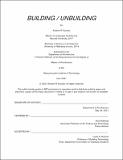Building / Unbuilding
Author(s)
Younker, Andrew R
DownloadThesis PDF (53.80Mb)
Advisor
Akšamija, Azra
Terms of use
Metadata
Show full item recordAbstract
Waves of recent protests across the United States confronting structural racism demand a reckoning with colonial and confederate histories which, far from being relegated to a distant past, continue to influence material and social formations in the present. A growing awareness of unstable environments destabilizes past collective memory-making while received mythologies are losing their power to define national narratives for the masses. The not-so-distant future is clouded with apocalyptic visions and existential threats. The present is haunted by both the past and future.
Reciprocal networks of memory building and unbuilding are inscribed upon the surface of the land, or buried below, out of sight and out of mind. National monuments and parkland infrastructures stand as attractor points in these networks, reifying hegemony and reaching simultaneously into the past and future to both define and control relationships between water, land, humans and non-humans.
This project traces the wake of the westward expansion of the United States through three of these sites and the watersheds they were constructed from. First, the Washington Monument which sits at the center of the National Mall, constructed from the wetlands of the Anacostia and Potomac Rivers. Second, the Jefferson National Expansion Memorial, also known as the Gateway Arch, which sits on ground stabilized by a levee at the meeting of the Missouri and Mississippi Rivers. Third, Mount Rushmore National Memorial, also known as the Shrine to Democracy, blasted and carved into ancient granite formations in the headwaters of the Missouri River.
The apparent inevitability and permanence of these monumental sites are challenged through a kind of counter-tourism that builds the unbuilding left in the wake of progress. Tools of the design disciplines are used to reveal inconsistencies that lie at the foundations of these monuments and the larger project of nation building, opening up space to engage with both the terror and beauty overwritten by the ongoing and incomplete project of settler colonialism. The project is here translated from a short film into text and still images.
Date issued
2021-06Department
Massachusetts Institute of Technology. Department of ArchitecturePublisher
Massachusetts Institute of Technology